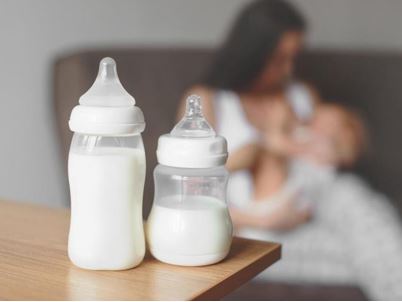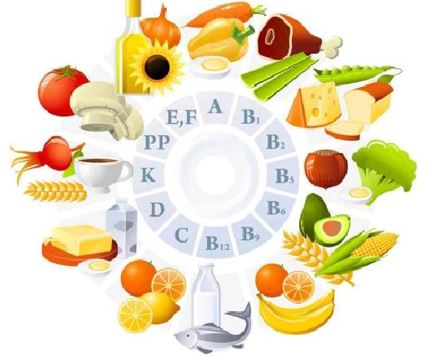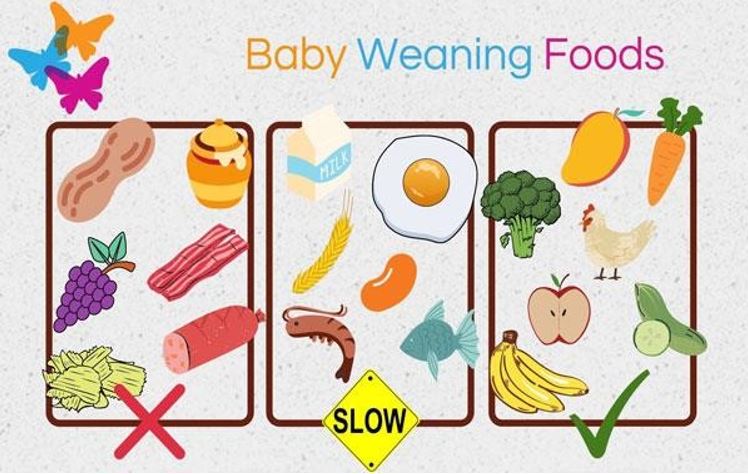
We know your baby is the most precious thing in the world to you and you’ll do anything to keep them safe, Breast-feeding is the best option for babies. When breast-feeding is insufficient or impossible, it is important to have access to high-quality infant formula. Nutrisaine milk formula that provides safe, high-quality and scientifically based infant formula. Giving your baby formula in addition to breastfeeding is known as supplementing, it’s completely fine and perfectly safe to do.
Many families choose this type of combination feeding method, many families choose this type of combination feeding strategy for a variety of reasons, low breast milk supply, convenience, or simply personal preference. In some cases, breastfeeding and providing formula may be advised by a doctor for medical reasons. For the first 12 months of life, the only safe alternative to breastmilk is baby formula.
It may take some time for a breastfed baby to adapt to bottle feeding because they must use a different sucking action.


Reflux affects nearly half of all babies. It is often called 'regurgitation' because you can usually see the milk coming back up after the baby's feed.
Regurgitation happens when babies bring up a small amount of milk, usually a teaspoonful without seeming to mind. Regurgitation is common in babies under six months old for completely normal physiological reasons and doesn’t require medication.
Reflux or regurgitation can occur because the ring of muscle between the esophagus (food pipe) and stomach is not fully developed. As a result, food or milk can return up the food pipe.
Some of the symptoms of a cow's milk protein allergy are similar to those of reflux, particularly in babies with eczema or asthma, or a family history of eczema or asthma.
Reflux affects about half of all newborn babies, and it's usually not a cause for concern. By the time they're 12 months old, nearly nine out of ten babies have gotten better. This is because a baby's digestive system develops over the first 12 months, and they spend more time upright as they begin to sit up.
Regurgitation is a normal and common symptom in infants. This is due to the infant esophagus's small volume capacity, as well as other factors such as their large liquid meals and the amount of time they spend lying down. Infants who have a lot of regurgitation, but no actual disease, have a condition that is called functional infant regurgitation. Functional means that the symptom is present, but there is no indication of a disease.


Reflux is more common in premature babies and babies who were born with a low birth weight. It's also common in babies and children who have muscle and nerve impairments, such as cerebral palsy, or who have a cow's milk allergy.
Even after burping for 10 minutes, your baby may regurgitate. If you're tired and worried about your baby regurgitating milk, don't put him down right away. Keep your baby upright to prevent milk from flowing back into the stomach. Remember that elevating your baby's head with a pillow will not reduce the risk of regurgitation; instead, it may suffocate him.
If your baby is showing reflux symptoms but isn't spitting up milk, they may have silent reflux, in which the milk flows back up to the esophagus (food pipe) and is swallowed by your baby. Silent reflux can be confusing, hard to identify and extremely frustrating. This is because while you may not be able to physically see what’s being brought back up, the baby reflux symptoms are still present.
Silent reflux has symptoms that are similar to those of regular reflux. The main difference between the two is that your baby will not bring up their milk after a feed if they have silent reflux.
Nutrisaine Anti- Regurgitation AR developed a formulation specifically designed for babies with frequent reflux and regurgitation. This formula gives the milk a thickened consistency on mixing, to help the milk to stay down in your little one's tummy and prevent regurgitation.
Nutrisaine Anti-Regurgitation AR is a nutritionally complete formula that can be used as a sole source of nutrition from birth to 12 months, or as part of a weaning diet.

There are a few things you can do to make your baby more comfortable if they have been diagnosed with reflux. Here are a few home remedies and handy tips for soothing baby reflux:
If your baby is happy and gaining weight, baby reflux is usually not a cause for concern. However, if your baby's vomiting becomes more forceful, begins after six months, lasts longer than a year, or has any of the problems listed below, it's best to contact your medical assistant, health visitor
During the first 10 days, knowing how to take care of your newborn baby can make these days full of fun and excitement and while also reducing stress. NUTRISAINE community is here to help you get off to a good start with a simple list of baby care tips for new moms!
Although your new-born may appear fragile and delicate to you, don't be afraid to touch, handle, or hold her! Matter of fact, studies show that babies who are held for more than two hours per day thrive and cry less. No baby care guide would be complete without this helpful advice!


Many first-time parents are taken aback by how many diapers their child goes through in a single day. To make your life easier, stock up on diapers before bringing your baby home. It's also a good idea to learn (and practice!) changing your baby's diaper ahead of time.
Many first-time parents are taken aback by how many diapers their child goes through in a single day. To make your life easier, stock up on diapers before bringing your baby home. It's also a good idea to learn (and practice!) changing your baby's diaper ahead of time.


Your baby’s sleep patterns change as she grows up. Newborns sleep for the majority of the 24 hours, waking up frequently during the day and night. Even so, you can still begin to develop a bedtime routine for your baby from as early as 6 to 8 weeks.
As your baby grows up she will develop a more structured nighttime sleep routine with fewer daytime "naps." You can help her in this by teaching her that nighttime is for sleeping, not playing.


Most babies cry for an average of 2 hours a day during the first 3 months. As shocking as it may be, it’s also normal.
To comfort your baby, first try to determine the cause of your baby’s discomfort. Is your baby hungry? Does she have gas? Is it time to change her diaper? Is it time for a nap? Is your baby over-stimulated by noise, lights or movement? Simple tips on how to handle a newborn baby can help you manage the situation with minimal panic. Your natural motherly instincts will also be activated without your knowledge!
Holding a sleepy or overstimulated baby on your shoulder while gently rocking her can help soothe her. Sing or speak softly to your baby, reassuring her with your soothing tone of voice. You can also help your baby relax by rubbing her back. Experiment with different positions until you find one that is comfortable for both of you.


Fever is common in young children. They are a common part of childhood and usually are not serious. In most cases, the fever usually goes away on their own. Fever is the body's way of killing infections by raising the heat on germs. It can be caused by bacteria, like strep throat, or virus, such as the flu. The key is to understand how and when to treat them so that you can keep your child comfortable until they're feeling better.
You can treat a fever when your child seems uncomfortable. It won't make their infection go away, but it will make them feel better. Sometimes a fever can make your child sleepy. If you don't treat a low fever, your child may be able to get more rest.
To safely reduce their fever, give them a child's dose of ibuprofen or acetaminophen. Children 6 months and older can take ibuprofen, while children 2 years and older can take acetaminophen. If your child is under the age of two, consult your doctor about the proper dosage.
A 15-minute bath in lukewarm water could help reduce your child's fever. Make sure the water does not become too cold, and remove them if they begin to shiver. Lightly clothe your child. In bed, cover them with a sheet rather than a blanket.
Give your baby formula or breastmilk on a regular basis. An oral rehydration drink for babies, such as Pedialyte, might be a good option. Encourage your child to drink more water after weaning. Avoid dehydrating drinks such as soda and caffeinated beverages.


During an illness, keep an eye on your baby's temperature and other symptoms and behaviors to see if you should see a doctor.
If you notice any of the following symptoms in your baby, you should contact his or her doctor or seek medical help:


Fevers are generally a symptom of a more serious medical condition. Your baby may develop a fever for many variety reasons, including:
Your baby is about to experience an incredible growth spurt. Babies triple their birth weight in their first year. They require a lot of nutrients to grow that much — more than at any other time in their lives.
Breast milk is the best source of nutrition for babies during the first six months, according to experts, but formula can also be a good option.
Some of the nutrients babies need to grow and stay healthy include:


Most infant formulas today are made from cow's milk. They are fortified to make them as close to breast milk as possible, and to give babies all the nutrients they need to grow and be healthy.
Nutrisaine milk formulas contain:
Babies who were born early before 37 weeks or at a low birth weight need special nutrition to help them catch up on growth. Breast-fed babies may get a fortifier added to their milk, which contains:
Your baby will be ready for their first taste of solid food around the age of six months. Most parents have a lot of questions about this important milestone, so we've put together a weaning guide for beginners to help you get started on your baby's weaning journey.

Weaning may appear to be a significant change, but it will occur gradually. Because your baby's stomach is still so small, they won't be able to eat full meals right away. Milk will continue to be their primary source of nutrition for the first year of life, but as the weeks and months pass, the amount of food your baby consumes will gradually increase.
Weaning can be stressful (how much are they eating and is it sufficient?). and, at times, a lot of work (who knew how much mess could be made in a single mealtime?), but for most families, introducing new flavors to your baby for the first time is also fun and exciting.
Weaning can usually begin around the age of six months. However, every baby is different so it’s best to begin weaning when they’re showing signs that they’re ready. Here are the signs to look for:
Sitting up unaided Your baby must be able to sit up and hold their head steady without assistance in order to swallow food safely without choking.
Hand-eye coordination is important. At first, babies will be clumsy, but they must be able to pick up food and put it in their mouth.
Swallowing food. Before they’re ready to wean, babies have a ‘gag reflex’ which pushes food back out of their mouth when they try to swallow it. When they reach around six months, the gag reflex moves further back in their mouth, which means they are ready to start eating.
One important reason for weaning is that babies need food. After the first six months of life, milk alone is no longer enough to provide all the nutrients they require.
But that’s not all, weaning has an important role to play in your child’s overall development. Babies who practice dealing with solid foods are also developing the mouth, tongue and jaw movements they need to begin talking. This is also why it's important to let the baby progress from purees to solid foods at his or her own pace.
Wait until your baby shows signs of being ready to wean, and then choose a quiet time when you aren't in a hurry. Eating may not be something your baby understands right away, so even though it may seem strange, it's best to introduce their first food when they aren't hungry. If their stomach is empty, offering a spoon or a cucumber stick that they don't know what to do with instead of their usual and expected milk feed may only frustrate them.
Your baby will not eat much at first, so begin with a single food taste once a day. Introduce new flavors gradually so that they get used to a range of tastes. Many parents choose to blend up or mash fruits and vegetables like broccoli, carrot, sweet potato or apple and offer a spoonful. Or you could provide cooked vegetable sticks that babies can grab and eat on their own.
There are certainly some foods that shouldn’t be given to babies. These include:
Honey. This can contain a bacterium that can be harmful to babies, so should not be given to babies under the age of one.
Whole nuts and peanuts. Whole nuts should not be given to babies. If you do want your baby to eat nuts, they must be crushed or ground up to avoid choking and if there is a history of food or other allergies in your family
Whole grapes. Before serving, cut them in quarters to avoid getting them stuck in your baby's windpipe.
Sausage, crisps, and bacon are examples of salty foods. Limit your baby's salt intake to no more than 1 gram per day.
Certain foods are more likely to cause allergic reactions than others. These are the following:
It's important to introduce these foods separately so you can figure out what's causing your baby's reaction. Don't be tempted to avoid these foods because recent research suggests that exposing your child to them from the time he or she is a baby may reduce the risk of developing an allergy.

It may take some time for your baby to learn to eat. It's all about experimenting with flavors and textures at first – and probably making a lot of mess! Don't be discouraged if your baby doesn't appear to be eating according to the rules. It's perfectly normal to play with food without eating much, just as it is to eat everything and ask for more. Your baby will thrive as long as they continue to receive milk feeds and gain enough weight.
Outside of mealtimes, it's best not to offer too many snacks at six months. Because milk still contains many of the most important nutrients, they shouldn't be overly satisfied with their milk feed. If you're out and about and want to provide a snack, try fruit or vegetable sticks.

This is a big concern for many parents, the first thing to mention is that it’s perfectly normal for babies to gag a little when they try to put too much food in their mouths. You can tell that this is different to choking because they’ will tend to cough and splutter, whereas choking is silent.
Choking is a real danger, so never leave your baby unattended with food and do not give them anything that could get stuck in their windpipe, such as whole grapes or nuts. You might want to take a baby first aid course before weaning your baby.
Lactose is the sugar that is found in the milk produced by all mammals, including humans. Sometimes people don't produce enough of the enzyme lactase in their gut to broken down the lactose.
Only a few babies are born with true lactose intolerance, a rare genetic condition in which they lack all lactase enzymes. (This condition is known as primary lactose intolerance.) Many people, however, develop lactose intolerance after the age of five. Aboriginal Australians, as well as people from Asia, Africa, the Middle East, and some Mediterranean countries, are more likely to have it.
If the lining of their gut is damaged by an illness like gastroenteritis, or an allergy or intolerance to another food, babies and young children can develop milk intolerance. This is called secondary lactose intolerance and will go away after the gut heals, usually over a few months.

Baby lactose intolerance is usually caused when your baby does not have or doesn’t make enough of a digestive enzyme called lactase. Lactase is produced in the gut, and it helps to breakdown or digest lactose in the diet.
The symptoms of lactose intolerance can be similar to other conditions, meaning that it’s sometimes are hard to identify. However, common symptoms include
Nutrisaine LF is a lactose-free infant milk for babies who are lactose intolerant, or who are experiencing symptoms such as diarrhea, tummy ache or wind caused by temporary lactose intolerance. Nutrisaine LF Lactose-Free Infant Milk is nutritionally complete, and suitable as the sole source of nutrition for infants from birth. For older babies, it can be used as part of a mixed diet. It is suitable from birth onwards .